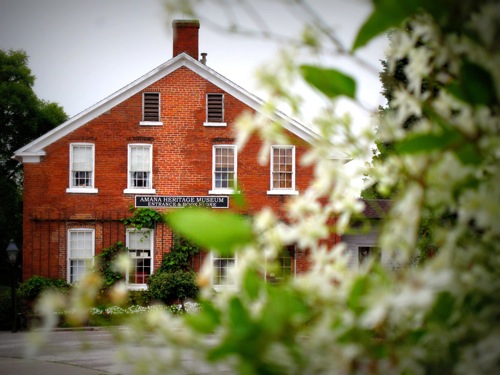
Courtesy Amana Colonies
I arrived one day before the Iowa Group Travel Association meeting to enjoy the historic ambiance of one of Iowa’s cultural highlights, the Amana Colonies. A National Historic Landmark that dates to the mid-19th century, the Amana Colonies is the site of a communal society that originated in Germany more than a century earlier. The group practiced a shared way of life for nearly 80 years before the Great Depression and societal changes led them to cease operating as a communal entity.
At the height of their communal existence, the Amana Colonies comprised six communities and more than 26,000 acres. Today, many structures dating to the settling of Amana remain. With local guide, Peter Hoehnle, I spent an afternoon visiting several of the Colonies’ prominent sites.
Hoehnle is a lifelong resident of Amana and has a home on the area’s most visited street, 220th Trail. Many homes there date to the middle 1800s and still have the trellises across the front that their original owners used to grow grapes for making wine. The entire street is captivating; retail shops, restaurants, museums and historic homes give it lots of character.
“Most groups do a full day here,” Sarah Tarnowski, executive director of the Amana Colonies Convention and Visitors Bureau told me afterward. “They’ll use a step-on guide for the morning and then have a free afternoon to spend time in the shops and museums.”
Hoehnle and I visited his Middle Amana Church, where 350 of the area’s 1,700 residents are still members. Men and women worship together but on separate sides of the sanctuary. There is no pastor; 11 elders, both men and women, lead the service. Woman once wore head coverings but today do not. Hymns are sung a capella.
Hoehnle, who inherited a bit of a German accent from his grandmother, treated me to a root beer at the High Amana General Store, a wonderful repository of miscellaneous memorabilia. Dating to 1857, the store is open seasonally now and is a favorite stop with visitors to Amana.
We also visited the Amana Woolen Mill, the enterprise that Hoehnle described as Amana’s “powerhouse” during its communal days. The mill still operates, producing blankets, scarves, and apparel in cotton, wool and acrylics.
Across the street from the mill, Millstream Brewing Company was established in 1985, the first brewery in Amana in more than a century. Hoehnle fittingly made it our last stop. Its most celebrated beer is its Schild Brau Amber, which has won 15 national awards. I had one later that evening on a side trip to Iowa City to visit the University of Iowa’s celebrated Old Capitol neighborhood.
I asked Tarnowski after my tour about special events that groups come in for.
“Our two largest events are Maifest each spring and Oktoberfest in the fall,” she said. “We get lots of groups for those two. They like to tie in a trip to Pella during Maifest to see their Tulip Time on the same trip. And quite a few do a Europe Without a Passport itinerary here that includes us, Pella, the Czech Village in Cedar Rapids and Decorah. That one trip includes German, Dutch, Czech and Norwegian heritages in Iowa.”









